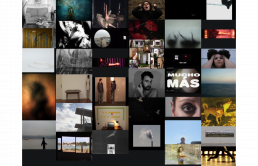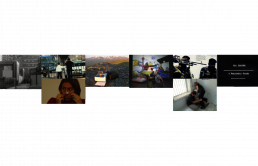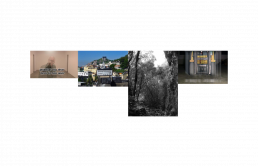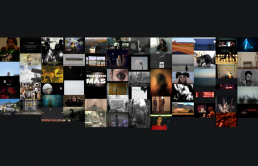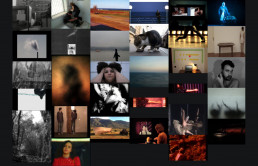“FUSO 2011 – Programação”
27 Julho, 22h
Museu Nacional de Arte Antiga
Curadoria de Pedro Lapa
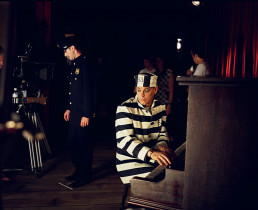
Rodney Graham, A Reverie Interrupted by the Police, 2003, 7’59’’
No centro de um palco com uma ostentosa cortina vermelha, há um piano à espera de ser tocado por um condenado que entra em cena acompanhado por um polícia. Com as mãos algemadas, o presidiário começa a tocar uma peça atonal improvisada, cujo dramatismo é marcado por intervalos de um silêncio prolongado. Finalmente, o polícia dá-lhe sinal e ambos saem do palco.

Yto Barrada, The Smuggler, 2006, 11’
Nos últimos 30 anos, T.M. viajou regularmente até ao enclave espanhol de Ceuta para contrabandear tecidos, roupas e artigos de marca encomendados pelos donos de lojas em Tânger. Por ser uma mulher idosa, os fiscais e os funcionários aduaneiros da fronteira geralmente não revistam o seu casaco.
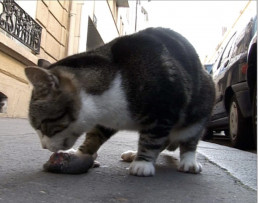
Adel Abdessemed, Birth of Love, 2006, 1’30’’
Este vídeo apresenta um grande plano de um gato a comer um rato na calçada perto do apartamento do artista na rua Lemercier. A câmara foi colocada diretamente no chão. A doçura do título, Birth of Love, parece contradizer o ato de devorar. É verdade que as imagens não demonstram violência – não vemos a presa a ser atacada, testemunhamos apenas a refeição. E a mastigação é feita de forma eficiente, sem crueldade. O gato come calmamente os intestinos, levantando a cabeça de vez em quando para verificar se não há outros predadores por perto. A inelutabilidade e a naturalidade da cena apresentam ao espectador uma mistura de doçura, inocência e violência típica da relação entre os animais, mesmo que esta decorra no ambiente “humano” de uma cidade.
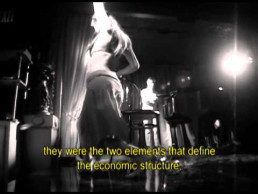
Francis Alÿs, Politics of Rehearsal, 2005, 30’
“É uma metáfora sobre a relação ambígua do México com a Modernidade, sempre a florescer, e ainda assim, sempre atrasada em relação ao momento em que irá de facto acontecer.”
Em Rehearsal 2 (2001-2006), uma stripper executa um zigue-zague dando um passo para trás e para frente através de uma performance constantemente em atraso.
Ao contrário de Rehearsal 1, Rehearsal 2 finalmente atinge o seu clímax, apesar de atrasos aparentemente infinitos. O vídeo Politics of Rehearsal mostra imagens cruas para este trabalho – essencialmente de um ensaio para um ensaio – enquanto a banda sonora consiste numa conversa entre Ales e Medina sobre a questão da modernidade no México.

Stan Douglas, Klatsassin, 2006, 18’11’’
Este vídeo estabelece um processo narrativo que desafia os limites da linguagem cinematográfica. Seguindo uma lógica recombinante com uma multiplicidade de pontos de vista sem começo ou fim, o filme apresenta cerca de 850 permutações sem repetição de um assassinato que é apresentado ao longo de um período de 70 horas. Com referência ao clássico de Akira Kurosawa, Rashomon (1950), a história é um processo narrativo em expansão, onde os níveis de intriga proliferam através de combinações, flashbacks e mudanças no enquadramento temporal.
23h30
Curadoria de Jean-François Chougnet
Com a presença de Zineb Sedira
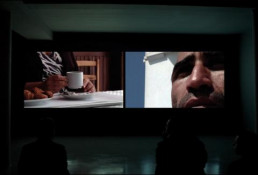
Zineb Sedira, Saphir, 2006, 16:9, 19’
Saphir apresenta dois protagonistas – um homem e uma mulher – sem que se suponha qualquer ligação entre eles. Ela fica no Hotel Es Safir, construído sobre o fundo do mar em frente ao porto de Argel. Ele passeia deambulando na área circundante. Só o mar e a visão unificam este romance sem palavras. Se a viagem é o significado do conhecimento, é também descoberta, revelação e desafio a ser medido. O movimento concretiza-se duplamente, quer na estadia na Argélia, quer na criação da obra: Saphir é o vídeo resultante.
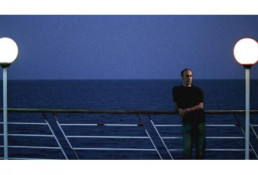
Zineb Sedira, MiddleSea, 2008, projeção monocanal, super 16mm transferido para suporte digital, 16:9, 16’
MiddleSea torna-se numa extensão de Saphir. Encontramos o mesmo ator, Samir El Hakim embarcando no ferry que liga Argel para Marselha. Sozinho, perdido em pensamentos, recorda, talvez, a viagem realizada por outros antes dele. A menos que seja a mulher de Es Safir, que vem à sua memória. De qualquer forma, é da responsabilidade do espectador estabelecer as bases para uma narrativa. Esboçar os contornos de uma história. E, especialmente, deixar-se levar pela avalanche de imagens que alimentam uma obra densa e de uma incrível beleza formal. A representação do mar não é mais um acessório (como em Saphir), é dominante. É o espaço que une e separa as comunidades, local de passagem para utopias e de exílio forçado ou voluntário.

Zineb Sedira, And the Road Goes On…, 2005, projeção monocanal, 4:3, 8’
Em And the Road Goes On… (2005), a paisagem desdobra-se através de encontros aleatórios ao longo do itinerário. Faixas de cores combinam-se entre si. O primeiro plano permanece totalmente presente, enquanto a velocidade vertiginosa de disparos sucessivos, conduz o olhar para o fundo distante, um horizonte de paz e mar.
July 27th, 10pm
Museu Nacional de Arte Antiga
Curatorship by Pedro Lapa

Rodney Graham, A Reverie Interrupted by the Police, 2003, 7’59’’
In the center of a stage with an ostentatious red curtain, there is a piano waiting to be played by a convict who enters the scene accompanied by a policeman. Handcuffed, the prisoner begins to play an improvised atonal piece, whose drama is marked by intervals of prolonged silence. Finally, the policeman gives him a signal and they both leave the stage.

Yto Barrada, The Smuggler, 2006, 11’
For the past 30 years, T.M. has made regular trips to the Spanish enclave of Ceuta to smuggle back fabrics, clothing and brand-name goods ordered by shop owners in Tangiers. Because she is an elderly woman, Tax and Customs Officers usually do not search inside her coat at the border.

Adel Abdessemed, Birth of Love, 2006, 1’30’’
This video is a close-up shot of a cat eating a mouse on the pavement near the artist’s flat on rue Lemercier. The camera was placed directly on the ground. The sweetness of the title, Birth of Love, seems to contradict the act of devouring. True enough, the imagery is free of aggression – we did not see the prey being attacked, we witness just the meal. And the chewing is done efficiently, without cruelty. The cat calmly eats the intestines, raising its head from time to time to check that no other predators are near. The ineluctability and naturalness of the scene present the viewer with a blend of sweetness, innocence, and violence typical of the relationship between animals, even if the artist has set this scene in the “human” environment of a city.

Francis Alÿs, Politics of Rehearsal, 2005, 30’
“It is a metaphor of Mexico’s ambiguous affair with Modernity, forever arousing, and yet, always delaying the moment ‘it’ will happen.”
In Rehearsal 2 (2001–06), a stripper performs a zig-zag stepping backwards and forwards through her constantly delayed performance.
Unlike Rehearsal 1, Rehearsal 2 does finally reach its climax, albeit after apparently endless delays. The video Politics of Rehearsal shows raw footage for this work – essentially a rehearsal for a rehearsal – while the soundtrack consists of a conversation between Alÿs and Medina on the issue of modernity in Mexico.

Stan Douglas, Klatsassin, 2006, 18’11’’
This video establishes a narrative process that defies the limits of cinematic language. By following a recombinant logic with a multiplicity points of view without beginning or end, the film presents some 850 unrepeating permutations of a murder that is presented over a period of 70 hours. Referring to Akira Kurosawa’s classic Rashomon (1950), the story is an expanding narrative process where levels of intrigue proliferate through combinations, flash-backs, and time-frame changes.
11:30pm
Curatorship by Jean-François Chougnet
With the presence of Zineb Sedira

Zineb Sedira, Saphir, 2006, 16:9, 19’
Saphir presents two protagonists – a man and a woman – without any link between them. It is located in the Hotel Es Safir, built on the seabed in front of the port of Algiers. He wanders around in the surrounding area. Only the sea and the vision unify this romance without words. If the journey is the meaning of knowledge, it is also a discovery, revelation and a challenge to be measured upon. The movement materializes doubly, both in the stay in Algeria and in this creation: Saphir is the resulting video.

Zineb Sedira, MiddleSea, 2008, single-channel projection, super 16mm transferred into digital, 16:9, 16’
MiddleSea becomes an extension of Saphir. We find the same actor, Samir El Hakim boarding the ferry that connects Algiers to Marseille. Alone, lost in his thoughts, perhaps he recalls the journey made by others before him. Unless it is the wife of Es Safir who appears in his memory. In any case, it is the viewer’s responsibility to build a narrative. Tracing the outlines of a story. And especially, let yourself be carried away by the avalanche of images that feed a dense work and an incredible formal beauty. The representation of the sea is no longer an accessory (as in Saphir), it is dominant. It is the space that unites and separates communities, a place of transition to utopias and a forced or voluntary exile.

Zineb Sedira, And the Road Goes On…, 2005, single-channel projection, 4:3, 8’
In And the Road Goes On… (2005), the landscape unfolds through random encounters along the route. Color bands match each other. The foreground remains fully present, while the dizzying speed of successive shots leads the gaze to the distant background, a horizon of peace and sea

